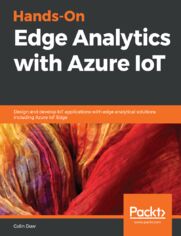Hands-On Edge Analytics with Azure IoT - Helion

Tytuł oryginału: Hands-On Edge Analytics with Azure IoT
ISBN: 9781838821319
stron: 253, Format: ebook
Data wydania: 2020-05-21
Ksi─Ögarnia: Helion
Cena ksi─ů┼╝ki: 109,00 z┼é
Design, secure, and protect the privacy of edge analytics applications using platforms and tools such as Microsoft's Azure IoT Edge, MicroPython, and Open Source Computer Vision (OpenCV)
Key Features
- Become well-versed with best practices for implementing automated analytical computations
- Discover real-world examples to extend cloud intelligence
- Develop your skills by understanding edge analytics and applying it to research activities
Book Description
Edge analytics has gained attention as the IoT model for connected devices rises in popularity. This guide will give you insights into edge analytics as a data analysis model, and help you understand why it's gaining momentum.
You'll begin with the key concepts and components used in an edge analytics app. Moving ahead, you'll delve into communication protocols to understand how sensors send their data to computers or microcontrollers. Next, the book will demonstrate how to design modern edge analytics apps that take advantage of the processing power of modern single-board computers and microcontrollers. Later, you'll explore Microsoft Azure IoT Edge, MicroPython, and the OpenCV visual recognition library. As you progress, you'll cover techniques for processing AI functionalities from the server side to the sensory side of IoT. You'll even get hands-on with designing a smart doorbell system using the technologies you've learned. To remove vulnerabilities in the overall edge analytics architecture, you'll discover ways to overcome security and privacy challenges. Finally, you'll use tools to audit and perform real-time monitoring of incoming data and generate alerts for the infrastructure.
By the end of this book, you'll have learned how to use edge analytics programming techniques and be able to implement automated analytical computations.
What you will learn
- Discover the key concepts and architectures used with edge analytics
- Understand how to use long-distance communication protocols for edge analytics
- Deploy Microsoft Azure IoT Edge to a Raspberry Pi
- Create Node-RED dashboards with MQTT and Text to Speech (TTS)
- Use MicroPython for developing edge analytics apps
- Explore various machine learning techniques and discover how machine learning is related to edge analytics
- Use camera and vision recognition algorithms on the sensory side to design an edge analytics app
- Monitor and audit edge analytics apps
Who this book is for
If you are a data analyst, data architect, or data scientist who is interested in learning and practicing advanced automated analytical computations, then this book is for you. You will also find this book useful if you're looking to learn edge analytics from scratch. Basic knowledge of data analytics concepts is assumed to get the most out of this book.
Osoby które kupowały "Hands-On Edge Analytics with Azure IoT", wybierały także:
- Microsoft Azure. Kurs video. Zostań administratorem systemów IT 169,00 zł, (76,05 zł -55%)
- Amazon Web Services (AWS). Kurs video. Zostań administratorem systemów IT 199,00 zł, (89,55 zł -55%)
- Flutter i Dart. Receptury. Tworzenie chmurowych aplikacji full stack 69,00 zł, (34,50 zł -50%)
- AWS dla architekt 139,00 zł, (69,50 zł -50%)
- In 119,00 zł, (59,50 zł -50%)
Spis tre┼Ťci
Hands-On Edge Analytics with Azure IoT. Design and develop IoT applications with edge analytical solutions including Azure IoT Edge eBook -- spis tre┼Ťci
- 1. Introduction to Edge Analytics
- 2. How Does IoT Edge Analytics Work?
- 3. Communications Protocols used in Edge Analytics
- 4. Working with Microsoft Azure IoT Edge
- 5. Using the Raspberry Pi with Azure IoT Edge
- 6. Using MicroPython for Edge Analytics
- 7. Machine Learning and Edge Analytics
- 8. Designing a Smart Doorbell Using Visual Recognition
- 9. Security and Privacy in an Edge Analytics World
- 10. What Next?





